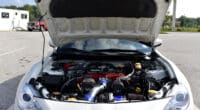Part of what makes the Scion FRS so great is that it is engineered to be a driver’s car. It is meant to handle exceptionally well and be especially fun on the back roads. Needless to say, it delivers.
The main complaint some owners have is that there is simply not enough power! With just about 200 hp from the factory out of a naturally aspirated engine, many have taken to forced induction to get the power they crave.
This is why FRS turbo kits aren’t uncommon, and if you want a bit more oomph from the FA20 engine, you should consider installing one too.
Cheap, off-brand turbo kits are a big no; these are not quality controlled components and even though they might work initially, they won’t last for long and might cause damage to your engine.
In this article, we’ll go over the main things you need to know about before going ahead with this upgrade, and we’ll conclude with some of the best Scion FRS turbo kits that you can buy.
Important Supporting Modifications

While some supporting upgrades are necessary for any turbo build, others are only required when you start pushing higher horsepower figures.
A bump of 50 hp, for example, is unlikely to require upgrades to your fuel system. If you start increasing power above 250 hp, however, you will need to factor in new fuel injectors and a fuel pump to handle the increased demand.
There is no hard and fast rule for how much a turbo kit for your FRS would cost and how you should go about the installation process.
There are multiple options, and depending on how much power you want, your requirements will be different from others who want more or less power than you do.
Generally, though, the higher the power goals, the more supporting mods you will need to perform.
Engine Internals

If you plan on hitting or exceeding 350 wheel hp in your FRS, you need to upgrade your internals beforehand.
The stock FRS engine can only handle so much power, and by the time you reach that threshold, you run the risk of causing serious damage to it. Forged internals, such as crankshafts and pistons, are often recommended.
This is not necessary if you plan on keeping power gains more modest, but is highly recommended when you start pushing 350 whp or more to ensure safety and reliability.
MAP Sensor
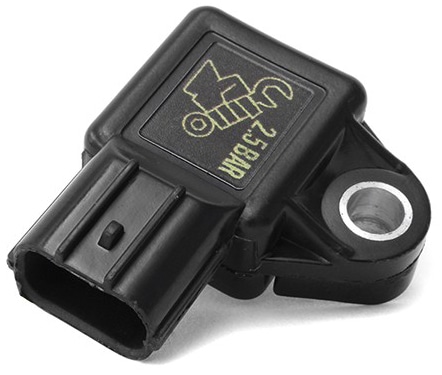
If you turbo your FRS, you have to replace your MAP sensor. MAP stands for manifold absolute pressure and it detects the mass air flow rate of the engine. This data is used to calculate the optimal amount of fuel to be injected into the cylinders.
The stock MAP sensor is not designed to handle turbocharged applications. Your FRS will not run properly with a turbocharger if you have not yet replaced this sensor.
You can buy MAP sensors for your turbocharged FRS on many websites. Some owners also used sensors from other cars.
Cooling

Your FRS will be hotter overall after installing a turbo kit. Replacing your stock radiator with a larger aftermarket one is a good idea to help increase cooling capability.
Another often recommended part is an oil cooler. You want to ensure your FRS runs without overheating, especially if you plan on taking it to the track or just going on spirited backroad drives.
Along with an oil cooler, you want to make sure oil gets to your turbo. Some aftermarket kits include a modified oil pan with lines to the turbo for this purpose.
Otherwise, you will want to modify or replace your oil pan so oil is able to travel to the turbo’s bearings.
Fuel System

If you plan on pushing more than 250 hp, it is recommended to upgrade your fuel system. This involves replacing both the fuel pump and the injectors.
If you neglect doing so, your engine is likely to run too lean (too little fuel being supplied). You will experience power loss and rough running conditions. A more powerful fuel pump and bigger fuel injectors will solve this problem.
How much of an upgrade you need to do to your fuel system is of course dependent on how much power you plan on adding. For instance, a 260 hp build is not going to need the same injectors as a 500 hp build.
Tuning
Getting your engine tubed is a mandatory part of turbocharging your FRS, or any car for that matter. You have fundamentally changed the car’s operation, and it simply will not run right unless it has been tuned for the new parts.
You have a few options. Some people buy their own tuning kits, such as Ecutek, and perform the tune themselves. Others take their car to a shop to get it done professionally.
Regardless of how you get your FRS tuned, do not skip this step! Your car will not fully reap the benefits of the turbo without it, and your performance will also be substantially decreased until you do so.
Best FRS Turbo Kits
Now that you have an idea of what needs to be done to your FRS prior to or during the turbocharger installation process, we can look at the actual turbos themselves.
If you’re on the look out for bolt-on twin-turbo kits, the options are extremely limited. Below you’ll find some of the best single turbo kits you can buy for your Scion FRS.
Works Stage 1/Stage 2

Manufacturer: WORKS Motorsport
Type: Single
Turbine: Garrett GT28 ball bearing
Warranty: 12 month/12,000 miles
Works offers either a stage 1 or stage 2 turbocharger kit for the Scion FRS. Both are carb compliant, meaning they are legal in all 50 states to use on the street.
The stage 1 kit is good for around 70 hp with a peak PSI of 7%, while the stage 2 is good for up to 90 hp with a peak PSI of 12%.
Their stage 1 kit is also referred to as their “simple” kit. It does not include as many items as the stage 2, and is a simpler install with fewer recommended supporting modifications.
It is considered a true bolt on, in that you do not have to upgrade your internals, or fuel system, or anything else in addition to popping the turbo on the car. The stage 1 kit does come with an ECU calibration as it is required for carb compliance.
The stage 2 kit, on the other hand, not only comes with more parts (a dedicated intercooler, for example), but more suggested add-ons.
Consider installing the Works drop-in air filter for better air flow (assuming you have the stock air intake box; if you have a cold air intake or a short ram intake).
We also recommend looking into their oil cooler kit to prevent overheating.
The manufacturer recommends stiffer motor mounts, as well as upgraded brakes (they offer a package deal for this, but if you have already upgraded to bigger brakes, you are fine).
The reason the stage 2 kit has a list of modifications to include is because it is a more powerful turbo running higher boost pressures.
The demand on your engine will be higher with a stage 2 versus stage 1 kit. However, this does not mean stage 2 is automatically better.
Instead, the best kit is whichever one most closely meets your needs. If you want to push as much power as possible, the stage 2 kit is best.
If you want a more affordable and simple install without having to worry about a whole bunch of additional parts, the stage 1 kit makes the most sense to buy.
You can also add on a tuning option; be sure to select the 2013-2016 model years when doing so for the FRS. The others are for the 2017+ GT86 and BRZ.
Greddy Tuner

Manufacturer: Greddy
Type: Single
Turbine: Greddy T518Z -10cm2 actuator turbo
Warranty: 1 year
Buy on: Enjuku Racing
If installed correctly, the Greddy Tuner kit will add 93+ hp to your FRS, and this has been tested on stock fuel pumps and injectors.
Granted, if you plan on adding nearly 100 more horsepower to your FRS, you really should think about upgrading your fuel system to prevent damage or loss of performance.
The kit comes with the turbo itself, an intercooler (and required piping), air intake, turbo manifold, as well as a downpipe and front pipe to replace the catalytic converters.
Sadly it has been discontinued, but it is definitely one of the best FRS turbo kits. Finding a used kit is always a possibility. Or you can check for availability using the link above.
HKS GTIII-RS

Manufacturer: HKS
Type: Single
Turbine: GTIII-RS
Warranty: 1 year
Buy on: Enjuku Racing
The HKS GTIII-RS turbo kit comes with the bold claim that FRS owners can hit an astoundingly high 440 hp!
Of course, most of us have no need or desire to run that wild of a setup, and you can buy this kit without pushing such high numbers. FRS drivers have hit 250 hp with this kit, as well as 400 hp, so you have a wide range.
You can expect to be able to make nearly 300 hp on the stock engine with no tune, and up to 430 or more with a tuned engine. Of course, if you plan on going for high power, be sure to upgrade your internals before doing so.
The kit includes a turbo, intercooler, and turbo manifold with the associated piping. It does not come with a tune though.
HKS recommends that you install 440cc fuel injectors, with 440cc being the minimum requirement if you purchase this turbo.
AVO Stage 2

Manufacturer: AVO Turboworld
Type: Single
Turbine: AVO18/49
Warranty: 1 year
The stage 2 kit from AVO is rated to add anywhere from 50 to 70 wheel hp to your FRS. It is unique in that it is mounted underneath the engine.
If you like the idea of a sleeper look, this turbo is not immediately obvious when popping the hood.
AVO’s stage 2 kit comes with an intercooler, a new MAP sensor to replace your stock one, a base tune from Ecutek, as well as a front pipe and crossover pipe.
They also include a mechanical oil pump to get oil to your turbo, which is installed on the back of your right camshaft, allowing the oil pump to work in time with the engine’s operation.
AVO recommends installing a blowoff valve, and they offer two options to choose from, so be sure to include this in your purchase so you do not end up with idling issues.
MAPerformance T3
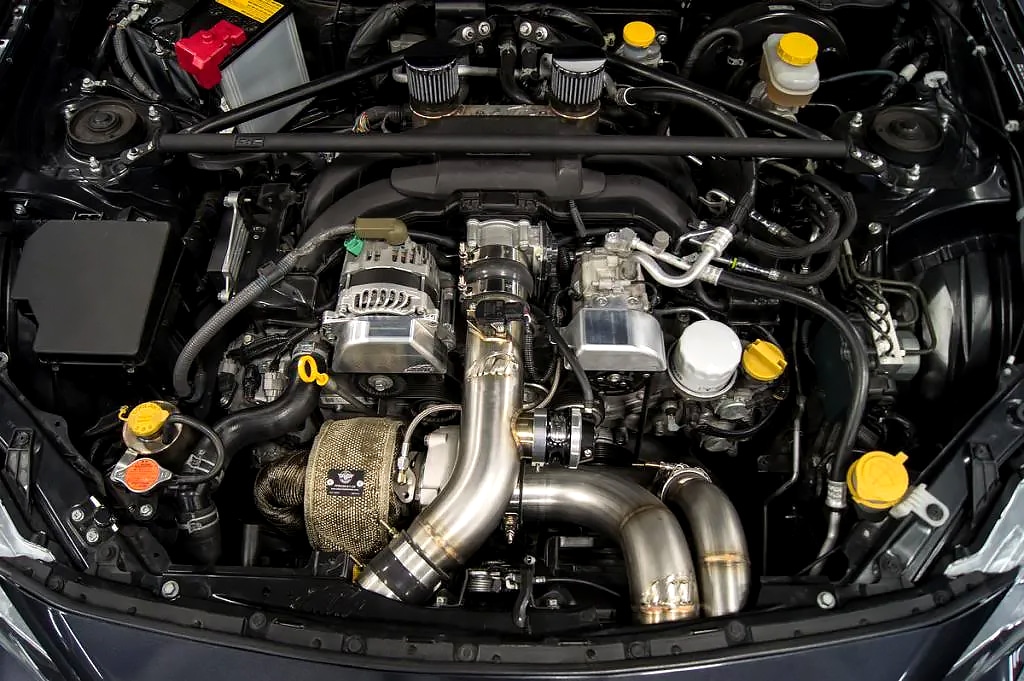
Manufacturer: MAPerformance
Type: Single
Turbine: Precision Ball Bearing or Journal Bearing Range
Warranty: None
The MAPerformance T3 turbo kit is probably the most comprehensive kit on our list. It includes a long list of components for your build, saving you the headache of having to find parts, compare their prices across the Internet, etc.
Some of the parts include:
- Cold air intake
- Downpipe with heat wrap
- Intercooler
- Blow-off valves (options to choose from)
- Plug and play fuel injectors (you choose the type you want)
- Upgraded fuel pump
- Oil pan modification for your turbo
- Radiator support
- Coolant overflow tank
- Dual oil catch cans
The turbo itself can be purchased with either ball bearings or journal bearings. Generally, ball bearings are superior to journal bearings in that they are more efficient and just work better.
However, ball bearing turbochargers are more expensive than journal bearing ones, so consider this before making a decision.
The MAPerformance turbo kit clearly offers a lot of options and parts, and it is also good for up to 100 hp gains. Not only this, but it is known for providing good midrange torque in particular.
This is important for FRS owners, who know of the infamous midrange torque dip.
Full Blown Stage 1/2

Manufacturer: Full Blown Motorworks
Type: Single
Turbine: Garrett / PTE / T3
Warranty: Lifetime
Like Works, Full Blown offers both a stage 1 and 2 turbo kits. Which one is best depends on what you are looking for. Regardless, both offer high maximum power output, with the stage 1 kit being rated up to nearly 450 hp!
You get to choose from different turbines, which will also change the price. Review each one to make sure you choose the one that matches your plans best.
Each kit comes with the most, if not all, of what you will need. The stage 1 kit includes:
- Intercooler with piping
- Upgraded fuel pump along with 550cc fuel injectors
- Blowoff valve and wastegate
- Downpipe
- Intake pipe, and a base map for tuning.
The stage 2 kit also includes a similar list of components. The main difference is that most of the stage 2 components are rated for more power.
For example, the intercooler is rated 700 hp in the stage 2 kit, while the stage 1 intercooler is rated at 550 hp. Additionally, in the stage 2 kit, the fuel injectors are upgraded to 1000 cc.
Both the stage 1 and stage 2 options offer a lot of potential power, with stage 2 kicking things up just another notch.
Greddy V3 GTX-R

Manufacturer: Greddy
Type: Single
Turbine: Garrett GTX-2867R Gen II
Warranty: None
Like the other Greddy turbo kits on our list, this one has also been discontinued. However, it is a great kit and worth mentioning, especially for those who plan on looking at the used market for their builds.
The V3 GTX-R, like the Tuner Turbo Kit mentioned above, came with an intercooler and required piping, air intake, turbo manifold, as well as a downpipe and front pipe.
Of course, you will need to get a tune if you buy this kit, and can no longer buy directly from Greddy.
This is not a major drawback, because aftermarket tuning for the FRS is readily accessible, and many tuning shops are very familiar with the platform and how to optimize it when forced induction is added.
JDL
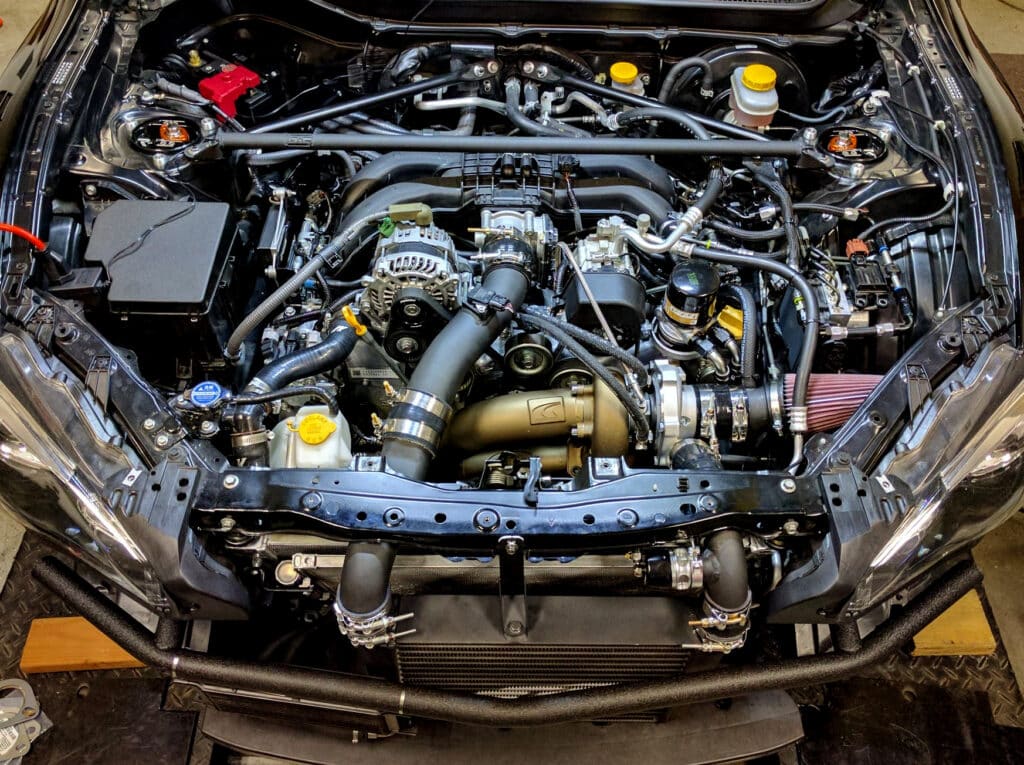
Manufacturer: JDL
Type: Single
Turbine: Garrett GT + GTX Range
Warranty: Lifetime (only for hot parts)
JDL offers a turbo kit with multiple options to choose from to optimize your build. This includes:
- A choice of equal or unequal length turbo manifolds,
- Intercooler with heat coating and required piping,
- MAP sensor,
- Oil pan,
- Wastegate
- Blowoff valve
- A choice of upgraded fuel pumps, injectors, and more.
The kit has been known to produce up to 177 hp gains (dyno tested). However, you can run much more modest boost levels. The 377 hp result was based on running 20 PSI, which is going to be stressful on your engine.
In other words, unless you plan on upgrading internals and other significant modifications to your FRS, stick with a lower PSI and get the power bump without sacrificing reliability.
Our Top Picks
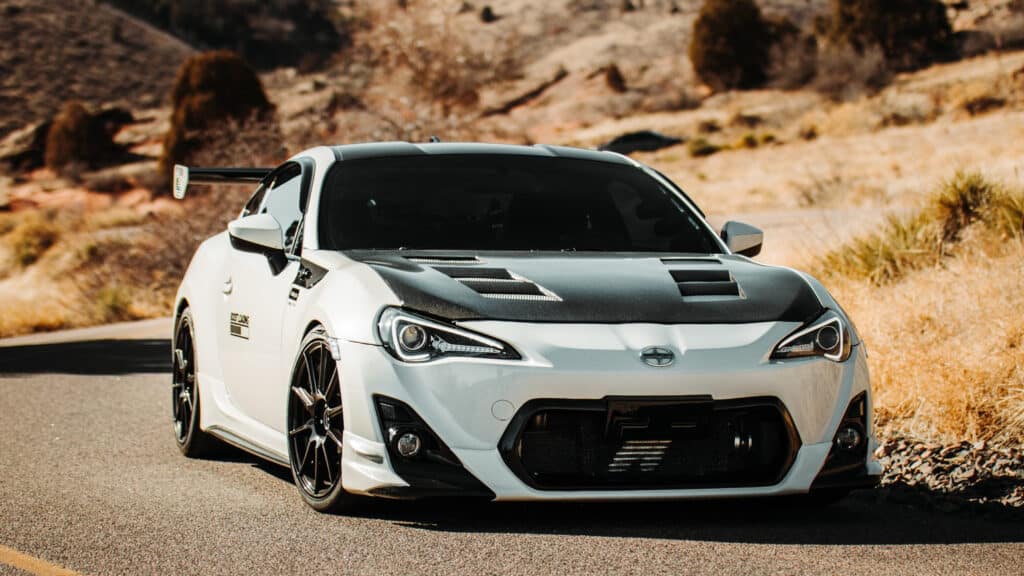
Turbocharging your FRS is a fairly complicated matter. For the most part, it is not a simple bolt on, and even the simplest of kits still require a fair amount of planning.
Luckily, the FRS has been and remains one of the best tuner cars loved by enthusiasts who want to modify it, test it, then modify it some more.
This gives us not only a large aftermarket for turbochargers, but a wealth of information about which one is best, dyno results, etc.
With that being said, we are confident these are among the best turbochargers you can buy, and while they are all good, here are our top picks.
Maximum Power: Full Blown Stage 2
If you plan on upgrading the engine internals, fuel system, cooling, braking, etc., and want to push as much power out of your FRS as possible, we recommend going with the stage 2 kit by Full Blown Motorworks.
A tuned and upgraded engine is likely to surpass the 600 hp mark! Remember this assumes a healthy motor to begin with, as well as being tuned correctly.
Most Reliable: Works Stage 1
If you want to add some power to your FRS, but ultimately want to maintain the daily drivability you have with the naturally aspirated engine, we recommend going with the Works Stage 1 kit.
You get a modest bump in hp, up to 50, which will definitely be noticeable on the street or on the track.
Also, the kit does not require a bunch of supporting mods, meaning it is the most bolt-on of all kits, in that you do not have to perform a bunch of prep work on your car prior to using the turbo like with some of the more extreme kits on this list.
Best Value: MAPerformance
Finally, what about the best kit for value? For this, we recommend the MAPerformance T3 turbo kit. You get impressive power gains of up to 100 hp, along with most parts you will need to fully utilize your new turbo.
You can include a new cold air intake, bigger injectors, a better fuel pump, etc., with the purchase of the turbo itself.
Which one of these turbo kits are you most interested in? Would you rather turbocharge or supercharge your FRS? Let us know by leaving a comment below.
If this article has helped you make a decision, do share it with your friends on Reddit, Facebook, or other online communities. We appreciate your support!

